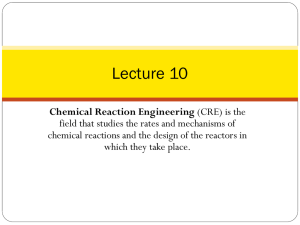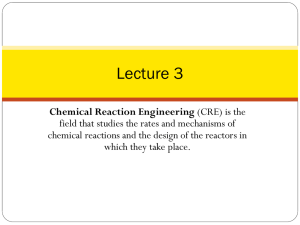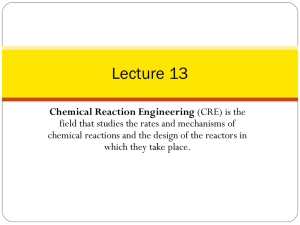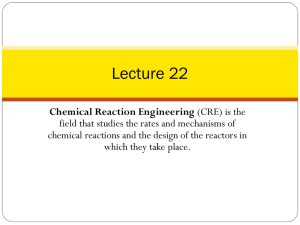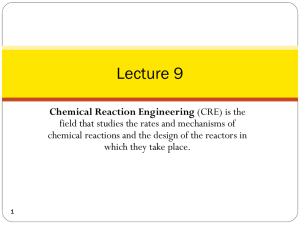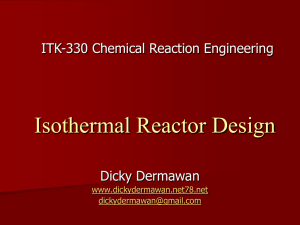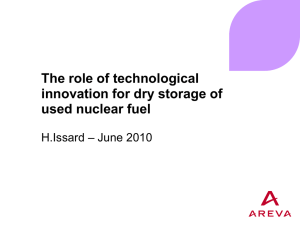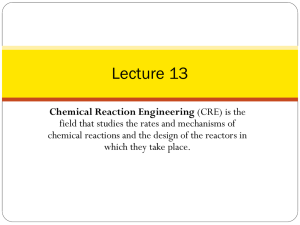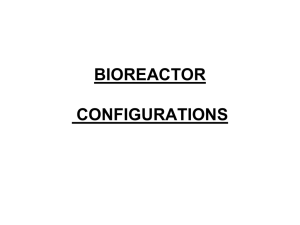Animated PowerPoint
advertisement
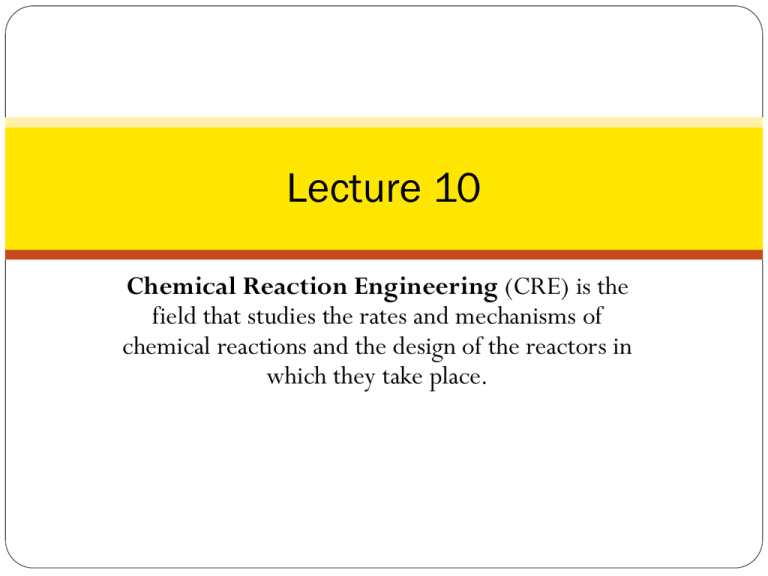
Lecture 10 Chemical Reaction Engineering (CRE) is the field that studies the rates and mechanisms of chemical reactions and the design of the reactors in which they take place. Lecture 10 – Tuesday 2/12/2013 Block 1: Block 2: Block 3: Block 4: Mole Balances Rate Laws Stoichiometry Combine Definition of Selectivity Semibatch Reactors 2 Selectivity in Multiple Reactions D A B D rD k D C A C B (Desired) A B U rU k U C A C (Undesired k 2 kU Selectivity ) Yield Instantaneous SD/U = rD/rU Y D rD / r A Overall ŜD/U = FD/FU YˆD F D /( F A 0 F A ) S D /U 3 2 B rD rU 2 k D C AC B k u C AC 2 B kDC A kU C B Keep CA high and CB low. Semibatch Reactors Semibatch reactors can be very effective in maximizing selectivity in liquid phase reactions. The reactant that starts in the reactor is always the limiting reactant. 4 Semibatch Reactors Semibatch reactors A+B→C+D B, v0 m Initial V A Liquid level and volume increase 5 Semibatch Reactors 1) Mass Balance: dm m dt m 0 0 dm dt dV dt 0 and dV dt 0 0 0 t 0 V V0 6 V V0 0t m V 0 Semibatch Reactors 1) Mole Balance on Species A: [in] – [out] + [gen] = [acc] 0 0 r AV dN A d [ C AV ] dt dV dt dC A 7 dt V dt 0C A V A dt dC A dt 0 rA dN CA dV dt Semibatch Reactors 1) Mole Balance on Species B: F B 0 0 rB V dN B dt d [ C BV ] dt dN B dt V dC B dt dV F B 0 C B 0 0 dC B 8 dt rB dt CB 0 C B 0 C B 0 V dV dt Semibatch Reactors 1) Mass and Mole Balance Summary 9 0C A 1 dC 2 dC B 3 dC C 4 dC D 5 V V0 0t A dt dt dt dt rA rB rC rD V 0 (C B 0 C B ) V 0C C V 0C D V Semibatch Reactors 2) Rate Laws 3) Stoichiometry 10 4) Parameters 6 rA 1 r A kC A C B rB rC 1 1 7 rB r A 8 rC rA 9 rD r A rD 1 N A0 N A 10 X 11 N A 0 C A 0V 0 12 N A C AV N A0 C A0 , V0 , 0 , k , C B 0 Semibatch Reactors 11 Semibatch Reactors 12 Equilibrium Conversion in Semibatch Reactors with Reversible Reactions Consider the following reaction: A B C D Everything is the same as for the irreversible case, except for the rate law: CCC D rA k A C A C B K C 13 Equilibrium Conversion in Semibatch Reactors with Reversible Reactions Where: C A C B N A 0 1 X V FB 0 t N A 0 X V C C CD At equilibrium, r K C C Ce C De C Ae C Be A N Ce N De N Ae N Be 0 N A0 X V then 2 N A0 X e 1 X e F B 0 t N A 0 X e Xe changes with time. 14 P6-6B - Semibatch Reactors Sodium Bicarbonate + Ethylene Chlorohydrin Ethylene Glycol + NaCl + CO2 NaCHO3 + CH2OHCH2Cl (CH2OH)2 + NaCl + CO2 A + B C + D + CO2 15 P6-6B - Semibatch Reactors Semibatch Reactors in terms of Moles A + B C + D + CO2 Mole Balances A B C D (1) (2) (3) (4) (5 ) Stoichiometry a dt dN b dt dN c r AV F B 0 rB V rC V dt ND NC 0 FCO 2 rCO 2 V CO 2 16 dN FCO 2 rCO 2 V r A rB rC r D rCO 2 (6) dV 0 CO 2 dt (7 ) Rate Laws 2 RHO (8 ) MW 44 (9 ) RHO 1000 (10 ) Ca N A V (11 ) CB N B V (12 ) r A kC A C B N a0 N a X N a0 N a 0 V0C a 0 (13 ) (14 ) 17 CO FCO 2 MWCO Rest of the Polymath Statements Similar to Concentration Program 2 P6-6 Semibatch: Moles, Na, Nb, etc. 19 20 21 P6-6 Semibatch: Concentrations CA, CB, CC 23 24 Semibatch Reactors Three Forms of the Mole Balances applied to Semibatch Reactors: dN 1. Molar Basis A r AV B F B 0 rB V dt dN dt 2. Concentration Basis dC A dt rA C A dC B 3. Conversion 25 dt dN V dt rB C B 0 C B dt dX 0 r AV N A0 0 dN V dt A r AV B F B 0 rB V Semibatch Reactors Consider the following elementary reaction: A+B C+D -rA=kCACB The combined Mole Balance, Rate Law, and Stoichiometry may be written in terms of number of moles, conversion, and/or concentration: Conversion dX dt k 1 X N Bi FB 0 t N A 0 X V0 0t dC A dt dC B 26 No. of Moles Concentration dt rA C A 0 dN V dt r A C B 0 C B 0 dN V dt A r AV B F A 0 rB V Polymath Equations 27 End of Lecture 10 28
